
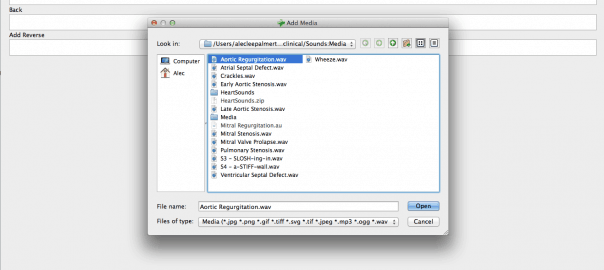
Every medical student has had occasional (or near-constant) thoughts that there aren’t nearly enough hours in the day. Class lectures, lab courses, discussion groups, assignments, clinic work, research projects, applications…it all adds up. For those of you using the Yousmle method, you already know the number of hours you can free up in your day simply by studying more efficiently. Here, I outline 9 tips to make even better Anki cards, streamline your studying, and free up time for life. Even if you don’t use Anki (yet) for your studying, many of these tips can help you save hours each day!
Table of Contents
1. Quick, Customized Screenshots for Media Cards
As the USMLE Step 1 exam continues to become more and more clinical, your ability to recognize every diagnostic clue is critical. Just like pharmacology = free points on the USMLE Step 1 exam, improving your simple recognition of histologic/radiologic findings can dramatically boost your score.
For Mac: to take screenshots of your entire screen and save it to the clipboard, hold “Command ⌘” + “control” + “shift,” then press “3“. You will hear the sound of a camera shutter. Then simply hit “Command ⌘” + “V” to paste it to your Anki “add card” fields. If you would like to take a screenshot of a particular part of your screen, hold down “Command ⌘” + “control” + “shift,” then press “4“. You will see a crosshair, which will allow you to highlight the area you would like to copy to your clipboard.
Here, I have use the “Command ⌘” + “control” + “shift,” then “4” command to copy an image to my clipboard. I then take that image, and copy it directly to an Anki card that will ask to identify what disease it is seen in.
For PC: Locate the “PrtScn” button at the top right of the keyboard. This will copy the active window to your clipboard. From there, you can paste it directly into your Anki card, or you can open the Paint application, paste it in there, and crop out parts you want to eliminate.
For a PC/Mac/Mobile complete tutorial, visit this website.
2. Reverse Cards
This option uses your card template to create two cards instead of one. This is particularly useful for reinforcing difficult-to-remember information, particularly since the USMLE Step 1 has so many different ways to ask questions. For example, you could be asked to identify hydralazine by name, or they might give you the mechanism of hydralazine and force you to identify it among the mechanisms of other drugs.
Normally, when you create an Anki card, it takes the “Front” field, in this case “Hydralazine – mechanism,” and uses that as the question. The answer, then, comes from the “Back” field (currently blank). A “Reverse” card takes the “Back” field, using it as the question, and turns the “Front” field into the answer. Here is how you set it up:
First, click on the Anki card “Type” (Basic).
Next, select “Basic (optional reversed card)”. This will add a new box below the “Back” field, called “Add Reverse.”
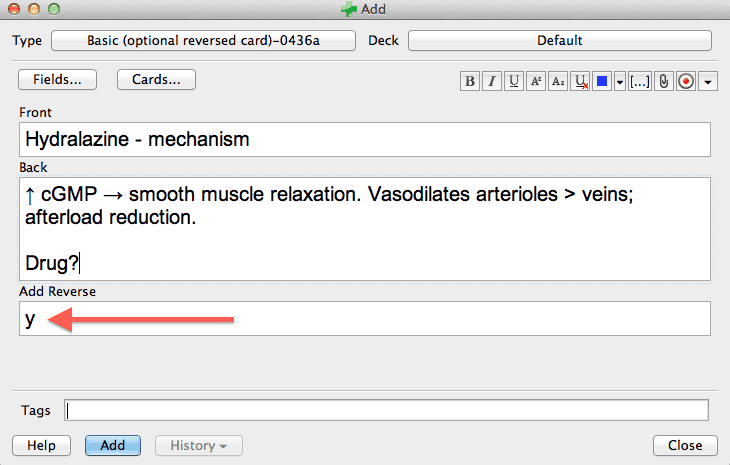
NOTE: it is easy to get carried away with reversed cards. Remember that if you reverse every card you make, you essentially make 2x the number of cards. Like all things in life, moderation will likely yield the best results.
3. Balance Information in the Forward and Reverse Directions by Rating the Difficulty (1-10)
Continuing with the “Forward/Reverse” theme, this tip is to get the most out of your forward and reverse cards. In particular, when most people begin with this, they load up all of the facts to recall on one side of the card, and make it relatively simple in the reverse. Pharmacology, again, is a common place to see this in. For example, consider the following example of a drug use (hydralazine). Here, you can see that the forward direction (4 items) is MUCH more difficult than the reverse (1 item – the name).
A useful exercise is to “Rate” your cards 1-10 based on how difficult you anticipate them to be. For example, the forward question, with 4 items, not all of which can be related to each other, would rate rather high, probably a 6-7. However, the reverse question would be much easier, which I would rate 2-3. Ideally, the difficulty of the forward/reverse cards would be similar, to minimize the number of repetitions,
Instead, it can be useful to move one or more facts from the forward to the reverse direction. Which you choose is up to you, but generally it makes reviews easier if you transfer item(s) that are most different from the others. For example:
Using forward and reverse cards, combined with balancing the difficulty in both directions can vastly speed up making cards, as well as Anki card review!
4. Use Audio Files to Crush USMLE Heart Sounds
As more and more audio files, particularly heart sounds, make their way onto the USMLE exams, the more important it is to include recognition of sounds into your repertoire. You can do much more with Anki than put in text and pictures. Click on the “Attach pictures/audio/video button” at the top right, or just hit F3, then select a particular sound you would like to add.
5. The Ninja Method to Learn Bug/Drug Pronunciations While Improving Your USMLE Pharm Scores
Virtually no first- or second-year medical student knows the correct pronunciation of drugs. It’s almost comical to think back to my first year, when I would quietly ponder questions like, “is it thy-AY-zides, or THY-ah-zides?” During the pre-clinical years, it never feels too pressing, though, since no one else knows the pronunciation, and they don’t test pronunciation on your exams.
Then our clinical years hit, and we feel like an idiot for not knowing how ANYTHING is pronounced.
To learn the pronunciations, a student in the Online Course has been using this website.
This is a new way to add audio pronunciations to your Anki cards. You can go to this site, and find the term you need, and download it.
From there, you can add it to your Anki card:
Select File:
Now, whenever this side of the card is reviewed, it will play the sound of the drug! Not only will this make you a superstar on wards for knowing the correct pronunciation of ALL THE DRUGS, but it will also help you remember the names of the drugs, which is critical for the USMLE Step 1 exam.
There you have it!
I hope you found these tips helpful! However, I have learned so much from the Yousmle community, and I’m sure there are many more useful tips out there. Please leave your favorite tip below in the comment sections!


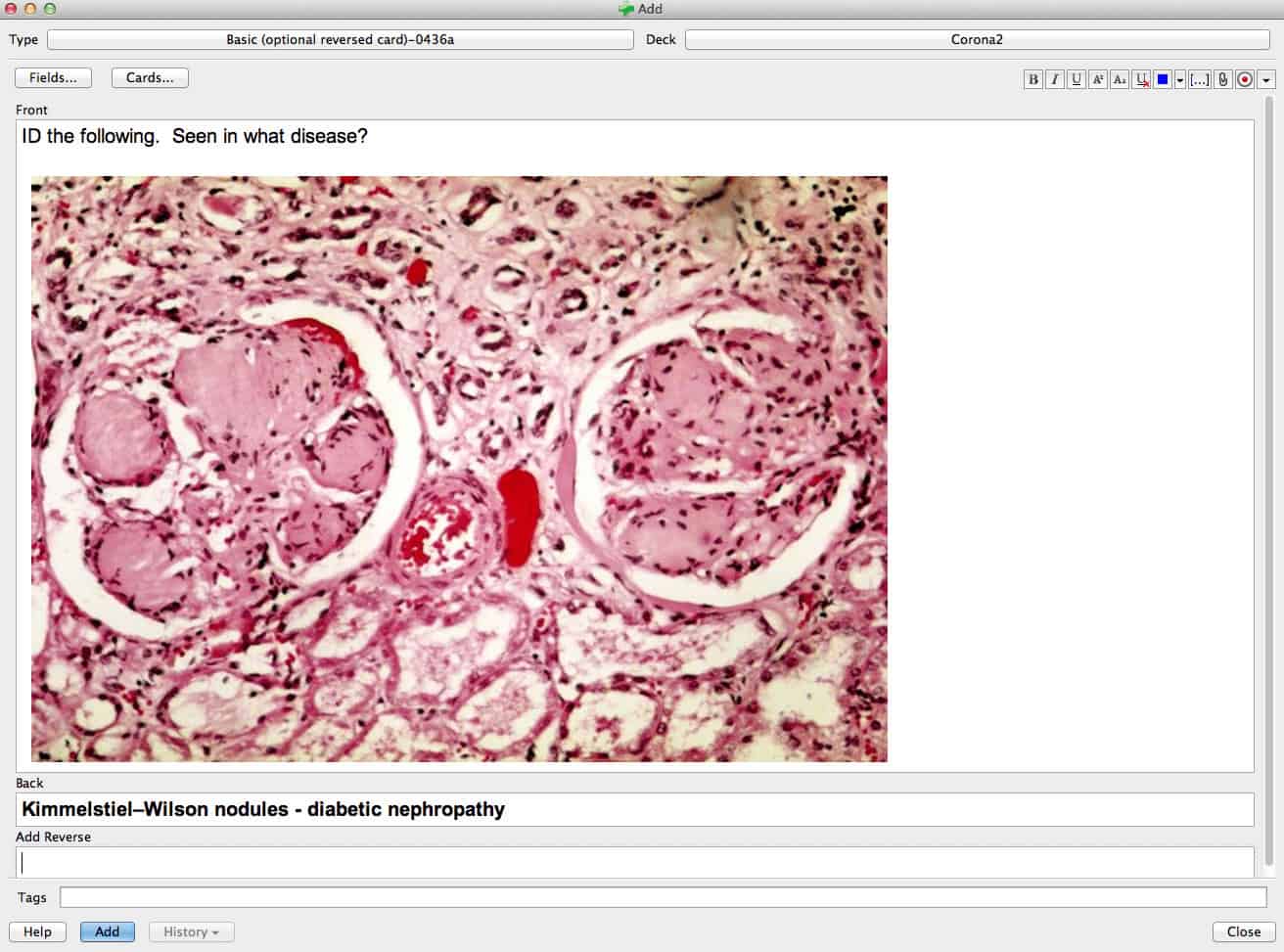
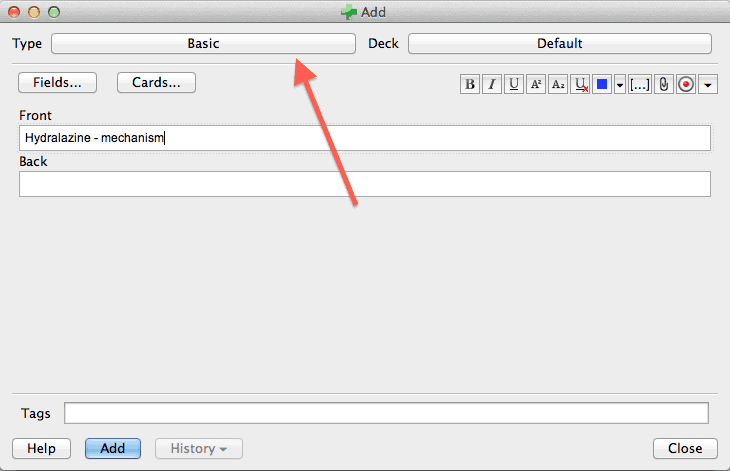
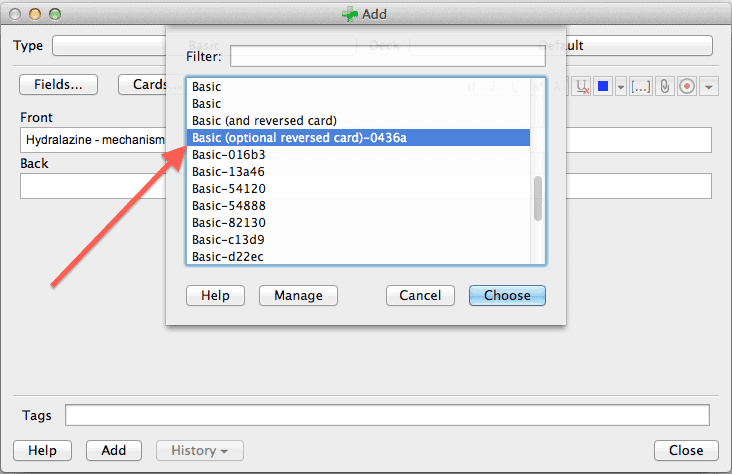
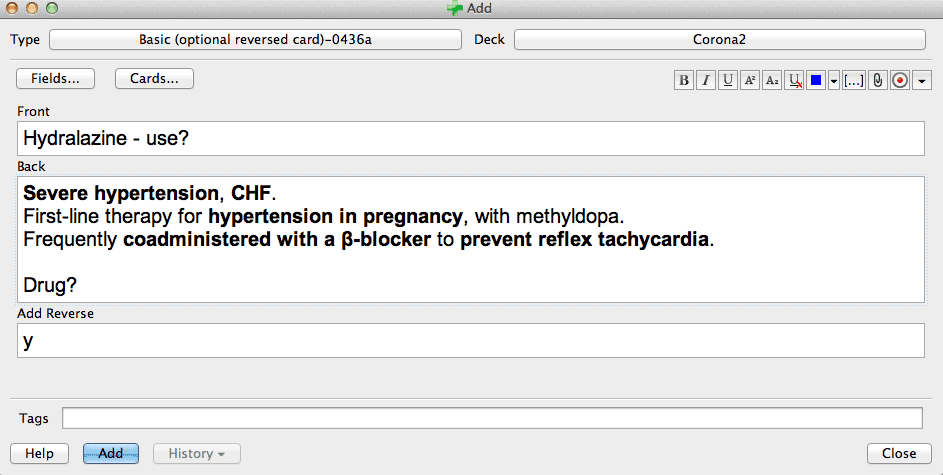
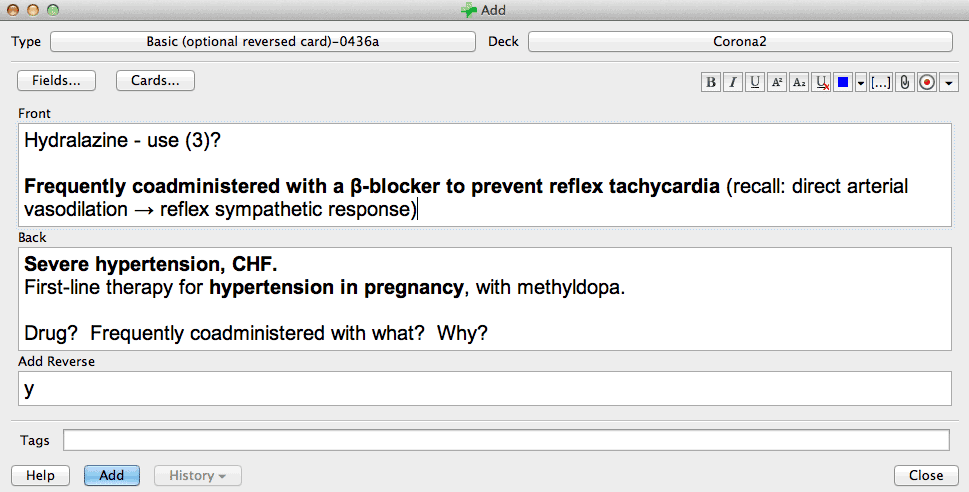
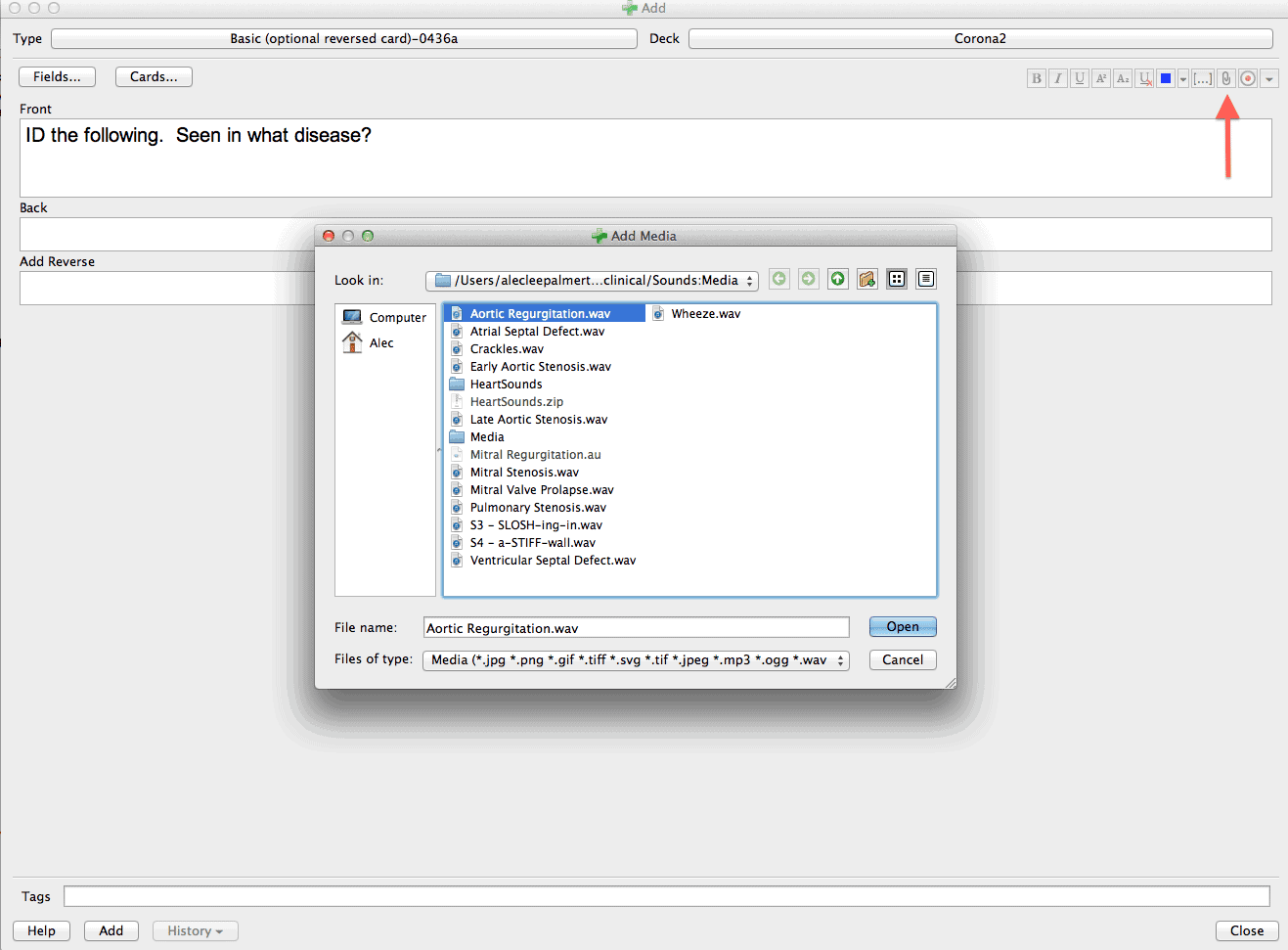










Hi Alec,
Love this site! Keep up the great work.
I’m a new second-year looking to clarify how Anki cards are used and the information they contain. Are you suggesting that we integrate the information from First Aid, med school lecture notes, Costanzo, Pathoma, etc. (or whatever outside resources one may be using) into our Step 1 Anki cards and then use only your Anki cards after that, or use them as extra review alongside those resources? I used Anki throughout first year and loved it, and feel confident in my ability to make effective cards, but not sure if I feel confident enough to only use my cards (plus question banks, of course) to study! Advice would be much appreciated. Thanks again!
Can I disable the reminder on Anki? It gets annoying when you have sooo many cards already. And I actually would prefer to use ppt or a simpler flashcard software mainly cuz I can just press next to move to another card and put marks on it too so I am not so comfortable using Anki.
Thank you for your message. I’m not sure which reminder you are referring to. Is this on the desktop version, or the mobile version? Other flash card programs may be more simple, but honestly, I haven’t found a better way to use space repetition, which is the real reason why Anki is so valuable.
It’s on the mobile version. I read somewhere you had the same problems too when u already had a ton of decks.. What did u do about it? Did u just ignore them?
You can disable in on ankidroid in the options, also unless you’re doing something really weird you won’t have spaced repetition in ppt so my advice would be to just use anki 😛
I couldn’t agree more!